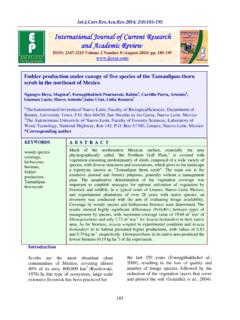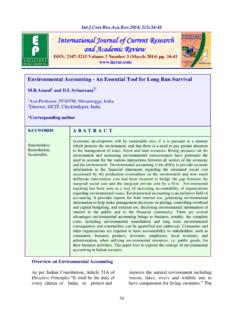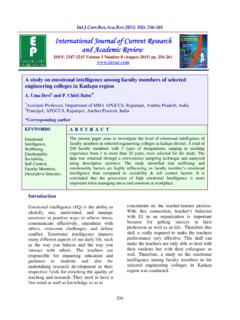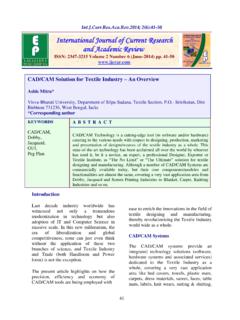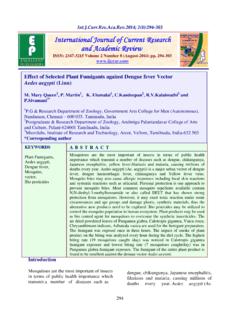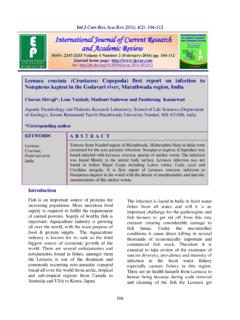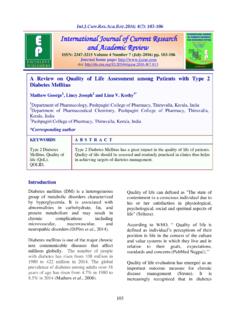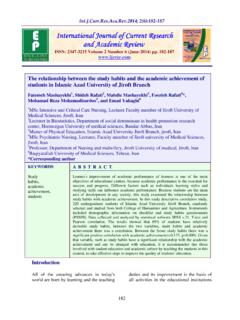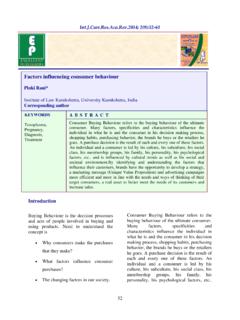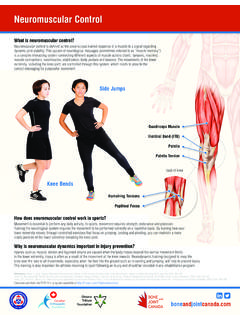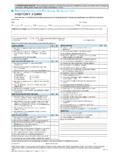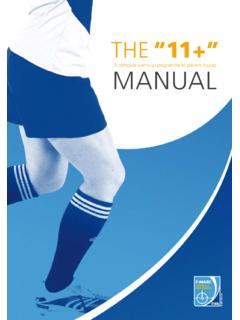Transcription of ISSN - IJCRAR
1 141 Introduction Volleyball as a sport is full in fast and explosive motions and techniques, along with power which is performed by each player repeatedly. These explosive and fast ABS TRACT The present research was carried out to compare the effects of aquatic and landing plyometric exercise (training) on defence jumping and attack, agility and pain feeling in female volleyball players. 41 elite volleyball players from shiraz clubs participated in the research voluntarily and were divided randomly in three groups of landing exercide (12), aquatic exercise (12) and the control group (13).The control group attended in the exercise of their own volleyball team. The empirical groups were doing plyometric exercise for eight (8) weeks in addition to volleyball.
2 Agility, defence jumping and three step jumping of attack were measured in three stages. 3 3 variance analysis was used for comparing sizes and groups, and independant T-test was used for repeated sizes and measuring level of pian feeling. The results showed that in defence jumping and attack, progress of aquatic group was higher in comparison to land group and the difference was significant (P%5). The level of muscular contusion was not significant at the end of eighth week (P%5). Also in the agility test no signigicant difference was observed (P%5). With respect to the progress of most subjects (cases) in the level of jumping height and agility in the aquatic group in comparison to land group, and also reduced injuries in them, it could be said that aquatic plyometric exercise is better than plyometric exercise on land because of adhesio and buoyancy properties of water.
3 KEYWORDS Plyometric, Defence and Attack, jumping, Agility Comparison of the effects of aquatic and landing plyometric exercise (training)on defence jumping and attack, agility and muscular contusion in female volley ball players , , , , and * 1 Department of Physical Education, Shiraz Education 2 of Fars, Fars, Iran 2 Department of Physical Education, Shiraz Univercity, shiraz, Iran 3 Department of Physical Education, Shiraz Education 1 of Fars, Fars, Iran 4 Department of Physical Education, Shiraz Education 1 of Fars, Fars, Iran 5 Cellular & Mollecular Research Center, Medical University of Yasuj, Yasuj, Iran *Corresponding author issn : 2347-3215 Volume 2 Number 6 (June-2014) pp. 141-154 142 motions along with maximum power and muscular ability is performed in shorter than one second, and the number of motions in one game (rally) is very high. For strengthening the techniques of this field all players are selected with tall stature, and having tall stature and extended hands is an important factor in finding talented volleyball players (aptitudes).
4 Therefore, with respect to the fact that all players are tall explosive power and jumping height are effective in their success rate on the net. On the other hand, players who jump well lose less energy, and their energy reserve takes longer to evacuate, and consequently they feel less pain and after a longer time. Therefore strengthening of jumping is an integral component in body-building programmes in the field of volleyball(2). Plyometric means placing muscles in tension at the beginning of contraction and the tension energy is reserved in the muscles and subsequently, the reserved energy improves power (strength) and speed in the next contraction. However, there are concerns over plyometric exercise because of the possibility of injuries during practice. As some researchers have mentioned various cases of intensive injuries of athletes world wide (all over the world), instances such as muscular strain, birds knee and tendon injuries have been observed during exercise(3).
5 Also scientists have reported increase of hydroxiprolin (muscular injury index) in serum after a course of plyometric exercise (25). An interesting topic in the science of practice is transfer of practice effects . The case means that whether exercise in a different environment (such as water or height) could improve the individuals function (performance) in the desired environment, and this is the question which has evenly attracted the attention of researchers. Previous research cases indicated increased jumping as a result of plyometric exercise on land (2,4,7,22), and few research cases have focused on similar studies in deep waters(20). Also several research cases have been carried out in shallow waters in which assessment of jumping has not been taken into consideration , and the effects of plyometric exercise on some other factors such as muscular injury indices(26),muscular mass index(10) and performance of quadriceps muscle(4) have been studied.
6 Also a research was carried out by Robinson etal. In relation to doing plyometric exercise in water and comparing its performance on land. In the research they studied the effects of the aquatic exercise an ability , speed and level of muscular pain in women, and showed that the effects of aquatic plyometric exercise on improvement of speed functioning and ability is the same as land performance , and the difference is that the aquatic gtoup reported less sentivity to pain and muscular pain, and the difference was significant(17). Miller etal. Studied the difference of effects of plyometric exercise in waist-high deep waters and chest-high deep waters on vertical jumping and reported the results as follows : the same rate of jumping improvement were observed in both methods of exercise(12). 143 Tsovrlov etal. Studied the effects of 24 weeks of resistance exercise on 12 elderly women over sixty in shallow waters and found the positive effects of nervo-muscular function and muscular strength in them , without feeling pain (24).
7 In his research, Thomas studied the effects of plyometric exercise on the agility of young football players and reported a significant difference. He believes that the strength of feet muscles have an important role in the rate of agility(25). Barens assessed the correlation rate of muscular strength and agility on female volleyball players and reported a positive significant correlation(1). As a result of playmetric exercise muscular strength is increased remarkably(13,18). Alami studied the effects of plyometric exercise on the agility of young badminton players. He states that plyometric exercise increase agility and recommends the use of such exercise in all athletic fields which need agility (22). with eight weeks of plyometric exercise by female volleyball players Lenert has reported the reduction rate of the time between pre-test and post-test in the agility test to be 31/0 of a second, showing that plyometric exercise improves agility , but the difference is not significant(9).
8 In his research, Starly studied the effects of plyometric exercise on land and in water on the strength of femural muscle, speed of running and vertical jumping of speed runners and concluded that: there was no significant statistical difference in pre-test between the three groups(aquatic exercise land exercise and control) in the three dependant variables. Statistically,there is a significant difference between improvement of running speed in aquatic exercise group with land and control group. A significant difference was observed in the strength improvement of femural muscle between aquatic exercise group and not in the land exercise group. Statistically, there was no significant difference between improvement of vertical jumping in the two exercise groups, while in comparison to the control group, the difference was significant(20). Also in another research case, Stem etal.
9 Compared the effects of six weeks of aquatic and on land plyometric exercise on jumping of 21 young male athletes . these individuals were divided in three groups of exercise in shallow water , knee-high depth ,on land exercise and control group . At the end of assessments they reported that both group had the same rate of progress in the improvement of jumping(21). A study on the effects of plyometric exercise on jumping in waist-high deep water, with chest-high deep water showed that : both exercise methods improve jumping to the same rate(12) . Also in a study on the effects of six weekes of aquatic and land plyometric exercise on ability, agility and muscular pain of eighteen young students, Shaffer showed that at the end of the exercise course, increase in the jumping rate has been the same in both aquatic and land groups, and the difference between the two groups, has been in the level of muscular pain(18).
10 Ploeg and his collegues studied the effects of plyometric exercise at the high level and low level in water and low level on land on the jumping rate , power and muscular torque, And after six weeks of practice , they reported that: the average of jumping in both aquatic groups ( high level and low level) had increase , but in the high level group the increase was significant , while in the land group a little reduction was observed(15). 144 Because of injuries caused by these exercises,the researchers decided to do the exercise in water to prevent injuries , and to find the best method for practice. But because these research cases are few, at present we can not say decisively that aquatic plyometric exercise is firstly as effective on improving muscular ability as doing it on land, and secondly prevents injuries ,and further research is necessary on different athletic fields especially volleyball.
